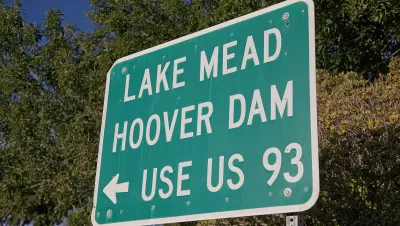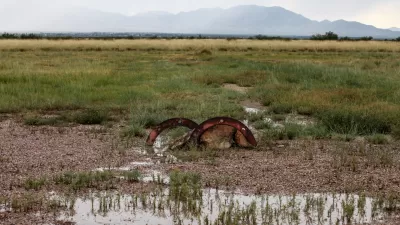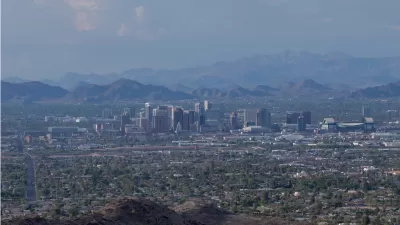As more and more people move to the suburbs blossoming in the Phoenix metro area, local water officials are increasingly concerned about the region's ability to keep up with demand.

Since before the pandemic, Phoenix has seen explosive growth as people seek out its affordable housing, warm climate, and work opportunities. But as Sarah Tory reports in High Country News, "[t]he region doesn’t appear to have enough water for all the planned growth."
Despite the looming threat of a dwindling water supply in the American Southwest, "people keep moving here — to the hottest, driest part of the country," Tory writes. The population of the Phoenix area is expected to grow to more than 7 million by 2040, with author and sociologist Andrew Ross calling it the "least sustainable city on earth." In addition to a small amount of groundwater and treated wastewater, "[m]ost of the valley’s water supply comes from the winter snowpack in distant mountains, which melts and flows through a vast system of dams, reservoirs and canals."
"A 2019 report published by the Kyl Center warns that in the long term there likely won’t be enough surface water available from the Central Arizona Project to replenish the groundwater used by all the homes currently planned for the Phoenix suburbs." The ambitious growth plans of many local cities pose serious questions about where future water supplies will come from. "Next year, water levels on Lake Mead, the largest reservoir on the Colorado River, are projected to drop to their lowest levels yet, triggering the first-ever official shortage declaration by the federal government. The declaration will cut Arizona’s Colorado River supplies by a fifth." As Tom Buschatzke, director of the Arizona Department of Water Resources put it, "[w]e’ll have to make some hard decisions."
FULL STORY: Rapid growth in Arizona’s suburbs bets against an uncertain water supply

Alabama: Trump Terminates Settlements for Black Communities Harmed By Raw Sewage
Trump deemed the landmark civil rights agreement “illegal DEI and environmental justice policy.”

Planetizen Federal Action Tracker
A weekly monitor of how Trump’s orders and actions are impacting planners and planning in America.

The 120 Year Old Tiny Home Villages That Sheltered San Francisco’s Earthquake Refugees
More than a century ago, San Francisco mobilized to house thousands of residents displaced by the 1906 earthquake. Could their strategy offer a model for the present?

In Both Crashes and Crime, Public Transportation is Far Safer than Driving
Contrary to popular assumptions, public transportation has far lower crash and crime rates than automobile travel. For safer communities, improve and encourage transit travel.

Report: Zoning Reforms Should Complement Nashville’s Ambitious Transit Plan
Without reform, restrictive zoning codes will limit the impact of the city’s planned transit expansion and could exclude some of the residents who depend on transit the most.

Judge Orders Release of Frozen IRA, IIJA Funding
The decision is a victory for environmental groups who charged that freezing funds for critical infrastructure and disaster response programs caused “real and irreparable harm” to communities.
Urban Design for Planners 1: Software Tools
This six-course series explores essential urban design concepts using open source software and equips planners with the tools they need to participate fully in the urban design process.
Planning for Universal Design
Learn the tools for implementing Universal Design in planning regulations.
Clanton & Associates, Inc.
Jessamine County Fiscal Court
Institute for Housing and Urban Development Studies (IHS)
City of Grandview
Harvard GSD Executive Education
Toledo-Lucas County Plan Commissions
Salt Lake City
NYU Wagner Graduate School of Public Service





























